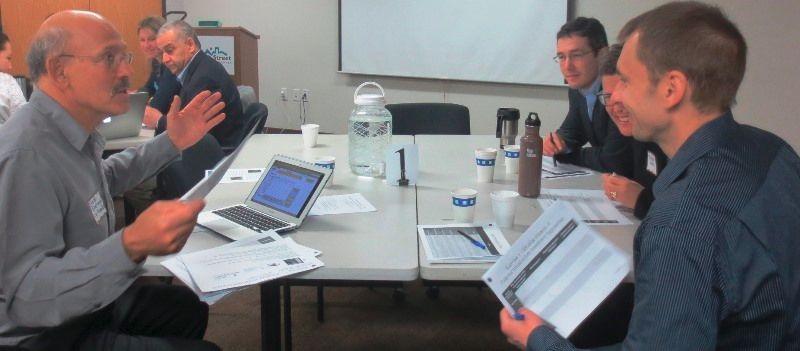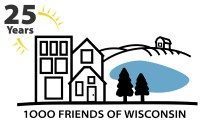Green Infrastructure Scenario Tool
 1000 Friends formed a partnership with The Sixteenth Street Community Health Center and Climate Interactive to hold workshops addressing the use of Green Infrastructure in the Kinnickinnic River watershed.
1000 Friends formed a partnership with The Sixteenth Street Community Health Center and Climate Interactive to hold workshops addressing the use of Green Infrastructure in the Kinnickinnic River watershed.
Together, we invited dozens of citizens and leaders from across the watershed to join in a series of workshops focused on using Climate Interactive’s Green Infrastructure Scenario Tool (GIST). The tool, which was created in partnership with MMSD, is a computer simulation tool used to test potential investment scenarios in green infrastructure.
The tool helps answer the following questions:
1. What are the benefits that might arise from a scale up of green infrastructure in the watershed?
2. Which infrastructure choices produce the benefits that residents of the watershed would most like to see?
3. What will it take to scale up green infrastructure in a way that would capture those benefits?
Why are the workshops important?
Over the next decade, state, regional and local agencies and individual residents and businesses will be spending millions on the following goals:
- Health – Reducing asthma, chronic disease, and other health issues
- Economic development – Creating good jobs, saving money, trimming costs
- Stormwater – Reducing flooding, basement backups and combined sewer overflows
- Energy costs – Reducing energy spending in order to invest in more of what matters
- Community connection – Providing places to play, gather, and enjoy
- Healthy water – Keeping the water that flows into rivers and lake clean
Instead of addressing these goals one at a time, the workshops brought together people from many sectors, armed with good strategies to influence investment in green infrastructure, steering toward opportunities that produced multiple benefits with greater results for less cost.
Green Infrastructure – solutions like green roofs and rain gardens that capture and purify water and provide both social and economic benefit – can address all of these potential problems.
Computer decision scenario tools can be used to project future consequences of a number of choices or investments. But, such tools can’t tell a community what combination of goals are of highest priority – only working together can do that.
The Workshops: Building a Broader, Stronger Voice for Green Infrastructure
Conversations with key stakeholders indicated that despite many good efforts, green infrastructure didn’t appear to be on the verge of “growing to scale”. While many ongoing projects in the watershed could provide opportunities for the installation of green infrastructure, this greater investment in green infrastructure wasn’t widely shared.
These observations led us to focus the workshops on the objective of building a broader, stronger, better informed voice to help bring green infrastructure in the watershed to its full potential.
 We found that the following were key to the overall success of the workshops:
We found that the following were key to the overall success of the workshops:
1. Diversity of participants
Feedback from participants frequently cited the diverse mix of participants as one of the strengths of the process, which built new relationships and made the common ground between issues more visible. People in attendance included:
- Health professionals
- Advocates for water quality, jobs, social justice, urban resilience and sustainability
- Planners, storm water engineers, public works staff and redevelopment experts
- Landscape architects and consultants
- Educators from the Milwaukee Public Schools and local universities
- Local business owners
2. Scenario Testing
The workshops were designed around groups of participants testing different scenarios to answer these questions:
- Where should available dollars be invested?
- What mix of green infrastructure is most desirable?
- Who needs to be involved?
These exercises encouraged people to learn from each other, question assumptions, and discuss their desired future for the watershed.
3. Looking For Opportunity
Groups of participants worked to identify opportunities for green infrastructure in each community. Participants pooled their knowledge and created opportunity maps for everything from private development projects to county parks planning to road construction projects. Consistent feedback from participants was that their understanding of potential opportunities increased as a result.
4. Local Expertise
Each workshop included speakers with practical knowledge of green infrastructure – from a business owner who had installed a green roof, to a college about to embark on a major storm water management project – these green infrastructure ‘veterans’ were honest in their assessment of what was working well, and what they would do differently the next time.
Key Insights from the Workshops

Doing nothing is not an attractive option:
Maintaining current infrastructure would set the people of the watershed up for more flooding, basement backups and combined sewer overflows.
Most people favored the benefits of investing in green infrastructure:
While investment in grey infrastructure might produce slightly more reduction in combined sewer overflows compared to green infrastructure, grey infrastructure investments didn’t deliver as many of the other co-benefits participants cared about.
Co-benefits include:
- improved air quality
- energy savings
- additional green space
- urban heat island reduction
Most people didn’t think that these benefits would be the outcome of business as usual:
Without increasing advocacy on behalf of green infrastructure, participants find it’s unlikely that its benefits would be realized. Participants recognized that creating their desired future for the watershed would require more collaboration, organization, and a sense of shared purpose.
No one group can do it alone:
Scenario testing with GIST showed participants that the scale up of green infrastructure requires contributions from all sectors:
- local businesses
- residents
- government
- non-profits
Participants agreed that continued education and outreach would be required to ensure the active participation of each slice of the community.
Not all green infrastructure is created equal when it comes to benefits:
Vegetation-rich types of green infrastructure, such as rain gardens, bio-retention and green roofs produced more helpful benefits than scenarios dominated by permeable pavement. Participants came to understand that it is the living, transpiring surface of plants that reduces the urban heat island effect and improves air quality. The ongoing advocacy of those who champion green infrastructure will be needed to make sure that green infrastructure isn’t viewed as one size fits all.
There is a need for ways to connect efforts and share learning:
The appetite for stories from the field seemed to indicate that there is a need for more learning about green infrastructure and for forums where people can ask for and offer support and resources, and where leaders in fields as diverse as health, jobs, and environment can support and learn from one another.
The idea of co-benefits provide a powerful framing for decision making:
Interviews with participants after the workshops demonstrated that many people have adopted the framing of co-benefits in thinking about the question of “green vs. grey” and many were even applying that framing to other issues in the community. In this way, the idea of co-benefits has provided a common language and reference point for thinking about investments, policy and priorities.
 Forward Momentum
Forward Momentum
In the final workshop participants strategized about how the insights from the workshops could influence planning and decision making about green infrastructure in the watershed.
The strategy elements that were identified included:
- Participants were carrying the multiple benefits of green infrastructure forward in their roles.
- Leaders in Green Infrastructure education and outreach are now equipped to use GIST.
- As a result of these workshops, Sixteenth Street Community Health Centers and 1000 Friends of Wisconsin staff are now experts in using GIST and can offer the same experience to other groups of stakeholders.
- Workshop participants hope to come together in high leverage collaborative projects.
- The workshops led us to realize:
- The value of sharing lessons and best practices across communities and sectors.
- The potential for successful projects to bring support to green infrastructure.
- The workshops led us to realize:
This work was made possible with the support of the Fund for Lake Michigan and the Surdna Foundation.

